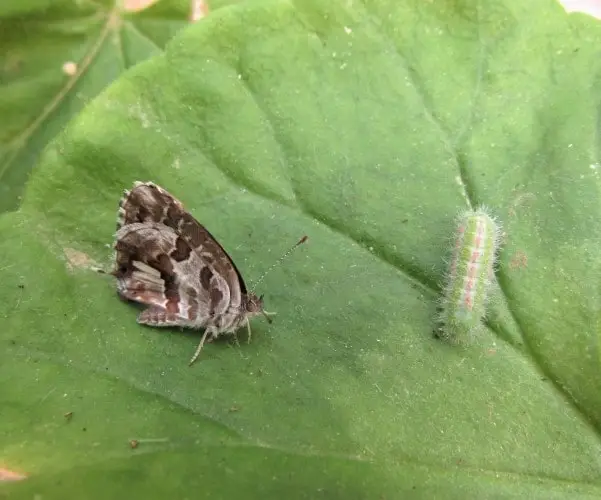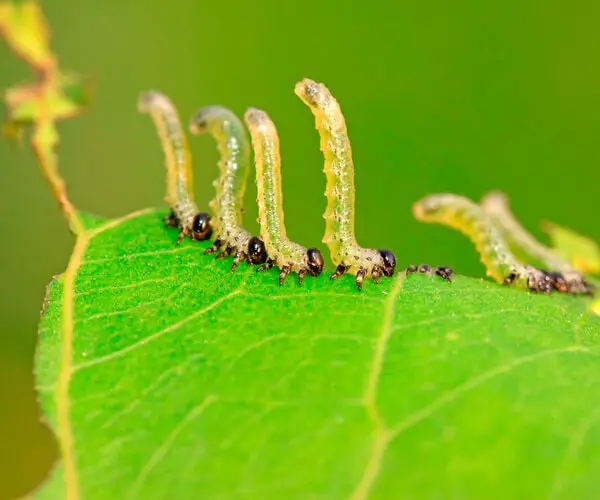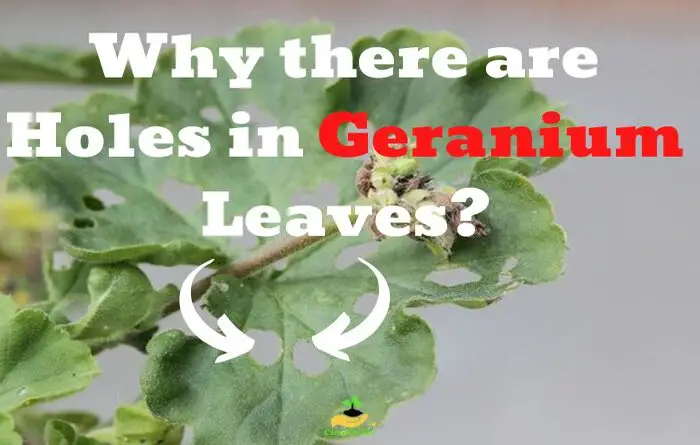Why there are Holes in Geranium Leaves? (3 Reasons)
Geraniums are probably one of the most popular plants to decorate balconies and terraces around the world and although they are resistant, holes may appear in their leaves. In this article we want to know why there are holes in geranium leaves, how to treat and recover this beautiful flower.
Holes in geranium leaves are caused by various pests, including the geranium bronze butterfly, geranium sawfly, and caterpillars. These insects feed on the leaves, resulting in the formation of holes. For treatment, inspect your geranium plants regularly and manually remove the pests. Consider using organic pest control methods or insecticides if necessary. Maintaining proper plant hygiene and providing adequate air circulation can also help prevent infestations.
| What causes Holes in Geranium Leaves: |
|---|
| 1. Geranium bronze butterfly |
| 2. Geranium Sawfly |
| 3. Caterpillars |
1. Geranium bronze butterfly

The popular geranium butterfly (Cacyreus Marshalli) is a deadly and silent pest of geraniums. Among its symptoms are holes in the leaves and stems of the geranium plant.
The borer (Cacyreus marshalli) is the most dangerous butterfly for geraniums. We can recognize it in different stages:
- Caterpillar is light green (occasionally yellowish). A hairy worm that eats the geranium leaves leaving holes or nibbles on them .
- This worm then forms a dark green chrysalis that turns brown as it approaches hatching.
- In its adult stage it is a small brown butterfly (similar to a moth) of approximately two centimeters that drills into the stem producing larvae that eat the sap of the stem (inside) and weaken the entire plant.
If you look among the branches and do not find green, hairy worms on your geranium, it is likely that they have already become a butterfly (moth). At this point there will only be one solution: intensively prune the geranium.
Geranium plants are attacked by this parasite during the hottest months of the year, from June to September, so be careful during these months.
These internal damage cause the weakening of its withered flowers and leaves, which consequently weaken the plant to the point of death in severe cases of attack.
Its caterpillars measure about two centimeters in length and have a greenish color that turns darker as they become adults. If its presence is anticipated, it is advisable to act through preventive treatments.
It occurs especially at the beginning of summer, around 68°F (20°C). At this time the plant has begun to sprout buds along with the arrival of heat. This time is perfect for the geranium moth to attack.
How to treat holes cause by Geranium Butterfly
In their natural habitat (Africa) geraniums can defend against caterpillars through biological control. In other parts of the world this is not possible and it is more difficult to put an end to the plague.
To eradicate the geranium worm, intensive pruning of all the damaged parts will have to be carried out (even if that means almost destroying the branches of our geranium).
Follow these steps:
- Disinfect some garden shears with alcohol.
- Prune away from the bottom any leaves with holes, yellowed or weakened branches, and dry or bitten leaves.
- Get rid of the remains and throw them away from the plant to prevent the butterflies from reappearing
- Then add a natural insecticide to the base of the remaining stems so that next summer the geranium can flower fresh again.
- Spray a microbiological insecticide based on Bacillus Thuringiensis, the same that is used against the box tree moth .
Another solution is the preparation of a strong garlic infusion.
Pour boiling water over a couple of peeled and crushed cloves along with 2-3 cloves of garlic, also peeled and crushed, and leave them to infuse.
The resulting liquid will be filtered once cold, then diluted and poured into an old bottle with a spray tip. The resulting garlic-flavored water should be sprinkled on the leaves of the geranium.
2. Geranium Sawfly

Geranium sawflies, which resemble the well-known wasps are small flying insects. The sawfly itself isn’t the biggest threat, it’s the small but voracious larvae (that hatch from their eggs) also called “false caterpillars” that eat geranium leaves causing holes.
The larvae look very much like small caterpillars and have variable colors depending on the species: the most common in the garden are pale green with black spots or streaks, but other species are whitish, brown, pale green, with or without black dots.
You can differentiate between sawfly larvae and caterpillars by looking at their legs and eyes:
- Unlike butterfly caterpillars, which have at most five pairs of abdominal prolegs, sawfly larvae have six to nine pairs (in addition to the three pairs of true thoracic legs, common to both species).
- Sawfly larvae have only one ocellus (a simple eye that only allows light variations to be seen) on each side of the head, whereas butterfly larvae have several eyes.
Females sawflies lay their eggs on the underside of young geranium leaves. After 7-10 days, larvae which resemble a caterpillar emerge from them, which at first can be very difficult to notice. First, they eat small holes in the geranium leaves, and growing up, they eat them whole.
Adult sawflies are harmless, but on the other hand, their larvae cause severe damage to geranium leaves.
You can easily spot an infestation of sawfly larvae by looking at the leaves. If you see holes there, it is very likely that your geraniums are attacked.
The damage is observed approximately from May to October, when the larvae are present and active. These false caterpillars have the main characteristic of forming an “S” with their bodies when threatened.
How to treat Geranium Sawfly
In particular, endangered plants such as roses and geraniums should be constantly checked for infestation by sawfly caterpillars. Spring is the best time to actually avoid major damage.
If caterpillars are found, they should be collected carefully. In addition, a spray of a mixture of cooking oil and water can reduce the activity of the caterpillars.
Generally, these false caterpillars are eliminated naturally by parasitic wasps, birds, viral and fungal diseases.
Unlike true caterpillars, geranium sawflies are not susceptible to Btk ( Bacillus thuringiensis ) treatment, since we have seen that they are not real caterpillars.
Avoid the use of commercial insecticide solutions, not specific to sawflies, which are dangerous for other useful insects and the environment in general, and especially systemic treatments whose action may persist for several weeks.
However, repeated sprays of liquid black soap are effective in killing visible larvae, but their action is not specific and may also eliminate beneficial insects: ladybugs, etc. It is therefore a treatment to be used only as a last resort.
Anyone who has grown geraniums at least once in their life, certainly has had to deal with caterpillars. The larvae begin to develop at the end of April and will feed on leaves, flowers and buds before becoming about 2 cm butterflies that cause great damage to plants, due to their insatiable appetite.
3. Caterpillars
If you see some holes in the leaves of your geraniums, it is very sure that they will have been the caterpillars. The way to get rid of them is to remove them one by one, along with their eggs, and use a specific insecticide.
Caterpillars settle on geraniums if planted in open areas. The first sign of their appearance is holes in the foliage of the leaves. Caterpillars are able to eat leaves until they destroy the geranium plant.
Symptoms to watch out for:
- The leaves are partially nibbled
- Flower buds are deformed and become hollow
- The flower stalks are covered with a black layer of droppings linked to the passage of caterpillars.
We are going to talk about caterpillars you have to know that you can find several types of caterpillars that love geranium leaves, but they are very easy to detect.
The signs of its presence are the eaten leaves and their droppings on the ground under the canopy of the plant, in the form of small dark beads.
There are caterpillars whose bodies are covered in hairs, which are their means of defense against predators. These hairs are poisonous causing burns and serious complications.
You will notice their presence starting from the end of May, with the appearance of the infamous black spots , which can be eliminated in a natural way.
Appear when growing geraniums outdoors and in flower beds. Caterpillars gnaw leaves, leaving holes in them. They are harvested by hand or treated with biological or chemical insecticides.
How to treat holes in Geranium leaves caused by Caterpillars
First, eliminate visible eggs and larvae with a cotton swab dipped in water and garlic. To keep the parasites away, you can then use the chili smoothie : blend three cloves of chili pepper together with glasses of water. Let it sit for a full day and then spray on the geranium leaves.
| Other Treatment Options | Description |
|---|---|
| Manual Removal | Inspect the plants regularly and pick off caterpillars by hand. Dispose of them away from the garden. |
| Organic Sprays | Use organic insecticidal sprays containing Bacillus thuringiensis (Bt) to target caterpillars. |
| Neem Oil | Apply neem oil solution to affected leaves, following the product instructions carefully. |
| Physical Barriers | Use floating row covers or mesh netting to prevent adult butterflies from laying eggs on the plants. |
How to Prevent Holes in Geranium Leaves
This plant can be kept healthy most of the time as long as all geranium care is followed. Above all, it needs constant moisture in the substrate and warm temperatures, fertilizer every week and keeping pests away by removing any yellow leaves or wilted flowers.
- Soil moisture: Use a soft substrate and a pot with good drainage. Water moderately so that the substrate is always moist but never waterlogged.
- Temperature: They can be placed indoors or outdoors depending on the climate of the place. Never leave a geranium outside at less than 10°C or it will not survive.
- Pruning of withered parts: Remove old leaves and withered flowers to prevent insects and butterflies from approaching.
- Autumnal pruning: To prevent it from getting sick after the summer, perform a drastic pruning of the leaves at ground level.
- Water it with water at room temperature, preventing overflow and drying.
- In winter, place cork or foam supports under the pot, feeding the geranium in a timely manner.
- Do not forget about proper lighting and regular ventilation of the room.
Aphids are very small insects (also called plant lice) that act on plants and especially on roses, visibly damaging them. In fact, they tend to alter the leaves which deprive the sap. The result is a visibly out of shape plant, with holes in the leaves and not very vigorous.
To eradicate it, it will be necessary to prune the fallen and damaged parts of the leaves and add a specific pesticide for the geranium butterfly.
We can find them in specialized stores for plants. Neem oil works well.
Ants are a less common case in geraniums. To keep them away, simply add lemon to the edge of the pot or an infusion of lavender in the substrate.




